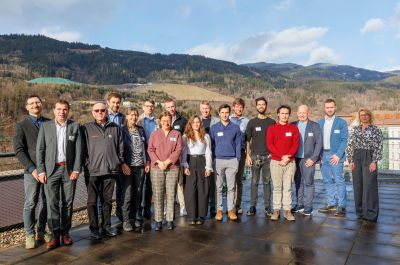
The Dust2Value project, led by Montanuniversität Leoben, has been launched to demonstrate the technical feasibility of a novel process for efficiently recovering valuable metals, primarily zinc and iron, from steelmaking residue streams.
The Dust2Value process uses green hydrogen to reduce zinc and iron oxides from the residue. The zinc metal evaporates due to the high process temperature, re-oxidizes with water vapor to form fine-dispersed ZnO particles, and exits the furnace via the off-gas stream. These particles are recovered in bag house filters and serve as a secondary zinc concentrate. Additionally, the process produces secondary-grade DRI (Direct Reduced Iron) that can be used within the Electric Arc Furnace (EAF) steelmaking route.
The innovative design of the Dust2Value process allows recovering heat and hydrogen during the re-oxidation of zinc vapor, enhancing resource and energy efficiency. Insights from basic research have led to an optimized process design that achieves exceptionally high extraction rates for zinc and a high metallization degree for iron.
The main goal of the Dust2Value project is to demonstrate the technical feasibility of the process concept within a TRL5 (Technology Readiness Level 5 - technology validated in relevant environment (industrially relevant environment in the case of key enabling technologies)) prototype. The project employs a holistic approach to sustainably recover valuables from secondary resources, strategically addressing various facets of the steelmaking residue recycling to resolve associated challenges.
- Recover iron and close the zinc cycle
- Prevent CO2 emissions
- Improve process efficiency of residue recycling
- Ensure sustainable recycling for various steelmaking residues
- Implement a digital twin of the prototype
- Design, build, and operate a scalable prototype
Based on global EAF steel production and the 15 - 22 kg of dust generated per ton of steel, the total annual potential for recycling steel mill dust worldwide is estimated at 7.4 - 10.4 million tons (based on the figures from the year 2020).
Therefore, a central project goal is to actively support the iron- and steelmaking industry in the transition towards a sustainable circular economy and green steel through and efficient treatment of by-product streams.
Project Coordinator:
Dr.mont. Manuel Leuchtenmüller
Montanuniversität Leoben
Lehrstuhl für Nichteisenmetallurgie
e-mail: manuel.leuchtenmueller@unileoben.ac.at
Tel.: +43 3842 402-5258
Mobil: +43 664 80898 5258
Project Partners:
- BEFESA R&D, S.L.U. (Spain)
- MAL Metallbau Anlagenservice-Leitungsbau GmbH (Austria)
- POLITECNICO DI MILANO (Italy)
- Georgsmarienhütte GmbH (Germany)
- INSPYRO NV (Belgium)
- BEFESA Steel Services GmbH (Germany)
